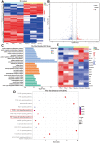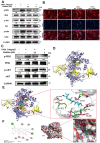Maslinic acid alleviates intervertebral disc degeneration by inhibiting the PI3K/AKT and NF-κB signaling pathways
- PMID: 38495003
- PMCID: PMC11187486
- DOI: 10.3724/abbs.2024027
Maslinic acid alleviates intervertebral disc degeneration by inhibiting the PI3K/AKT and NF-κB signaling pathways
Abstract
Intervertebral disc degeneration (IDD) is the cause of low back pain (LBP), and recent research has suggested that inflammatory cytokines play a significant role in this process. Maslinic acid (MA), a natural compound found in olive plants ( Olea europaea), has anti-inflammatory properties, but its potential for treating IDD is unclear. The current study aims to investigate the effects of MA on TNFα-induced IDD in vitro and in other in vivo models. Our findings suggest that MA ameliorates the imbalance of the extracellular matrix (ECM) and mitigates senescence by upregulating aggrecan and collagen II levels as well as downregulating MMP and ADAMTS levels in nucleus pulposus cells (NPCs). It can also impede the progression of IDD in rats. We further find that MA significantly affects the PI3K/AKT and NF-κB pathways in TNFα-induced NPCs determined by RNA-seq and experimental verification, while the AKT agonist Sc-79 eliminates these signaling cascades. Furthermore, molecular docking simulation shows that MA directly binds to PI3K. Dysfunction of the PI3K/AKT pathway and ECM metabolism has also been confirmed in clinical specimens of degenerated nucleus pulposus. This study demonstrates that MA may hold promise as a therapeutic agent for alleviating ECM metabolism disorders and senescence to treat IDD.
Keywords: NF-κB; PI3K; intervertebral disc degeneration; maslinic acid; senescence.
Conflict of interest statement
The authors declare that they have no conflict of interest.
Figures






Similar articles
-
Dihydroartemisinin Attenuated Intervertebral Disc Degeneration via Inhibiting PI3K/AKT and NF-κB Signaling Pathways.Oxid Med Cell Longev. 2022 Sep 9;2022:8672969. doi: 10.1155/2022/8672969. eCollection 2022. Oxid Med Cell Longev. 2022. PMID: 36120596 Free PMC article.
-
Maltol ameliorates intervertebral disc degeneration through inhibiting PI3K/AKT/NF-κB pathway and regulating NLRP3 inflammasome-mediated pyroptosis.Inflammopharmacology. 2023 Feb;31(1):369-384. doi: 10.1007/s10787-022-01098-5. Epub 2022 Nov 19. Inflammopharmacology. 2023. PMID: 36401729 Free PMC article.
-
Melatonin mitigates matrix stiffness-induced intervertebral disk degeneration by inhibiting reactive oxygen species and melatonin receptors mediated PI3K/AKT/NF-κB pathway.Am J Physiol Cell Physiol. 2024 Nov 1;327(5):C1236-C1248. doi: 10.1152/ajpcell.00630.2023. Epub 2024 Sep 9. Am J Physiol Cell Physiol. 2024. PMID: 39250820
-
NF-κB signalling pathways in nucleus pulposus cell function and intervertebral disc degeneration.Cell Prolif. 2021 Jul;54(7):e13057. doi: 10.1111/cpr.13057. Epub 2021 May 24. Cell Prolif. 2021. PMID: 34028920 Free PMC article. Review.
-
Maslinic Acid: A New Compound for the Treatment of Multiple Organ Diseases.Molecules. 2022 Dec 9;27(24):8732. doi: 10.3390/molecules27248732. Molecules. 2022. PMID: 36557864 Free PMC article. Review.
Cited by
-
Exploration of the Relationship between Polycystic Ovary Syndrome and Recurrent Pregnancy Loss Based on Bioinformatics.Endocr Metab Immune Disord Drug Targets. 2025;25(7):569-581. doi: 10.2174/0118715303308816240918062247. Endocr Metab Immune Disord Drug Targets. 2025. PMID: 39364875
-
Interaction between Maslinic acid and HSF1 enhances the ubiquitin degradation of HSF1, resulting in the inhibitory effect of pancreatic cancer.Discov Oncol. 2025 Jun 12;16(1):1069. doi: 10.1007/s12672-025-02786-8. Discov Oncol. 2025. PMID: 40504349 Free PMC article.
References
-
- Wang F, Cai F, Shi R, Wang XH, Wu XT. Aging and age related stresses: a senescence mechanism of intervertebral disc degeneration. Osteoarthritis Cartilage. . 2016;24:398–408. doi: 10.1016/j.joca.2015.09.019. - DOI - PubMed
-
- Qiu X, Liang T, Wu Z, Zhu Y, Gao W, Gao B, Qiu J, et al. Melatonin reverses tumor necrosis factor-alpha-induced metabolic disturbance of human nucleus pulposus cells via MTNR1B/Gαi2/YAP signaling. Int J Biol Sci. . 2022;18:2202–2219. doi: 10.7150/ijbs.65973. - DOI - PMC - PubMed
MeSH terms
Substances
LinkOut - more resources
Full Text Sources
Miscellaneous

